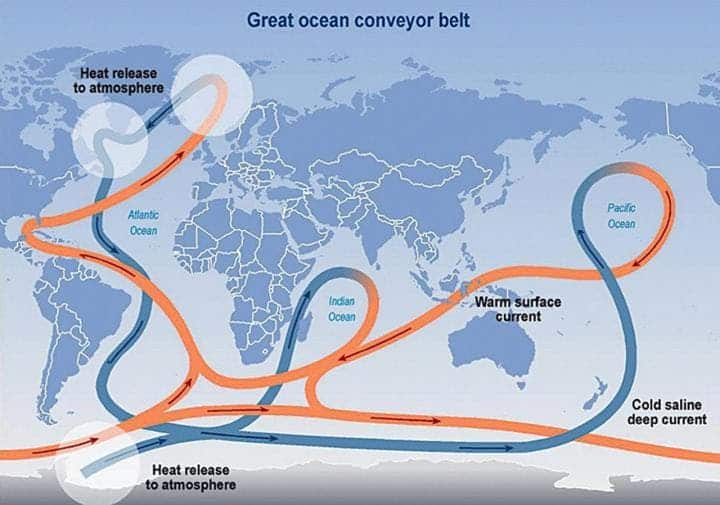
The circulation of the Atlantic Ocean plays a key role in regulating the climate on a global level. Scientists have always known that this constantly moving system of deep-water circulation can vary in amplitude. However, a new study is surprising because it suggests the Atlantic’s circulation is at its weakest point in 1,600 years. If this trend continues, it could disrupt weather patterns all the way from the United States to the African Sahel.
The Little Ice Age and modern global warming
The Atlantic’s deep-water circulation is part of a constantly moving system of deep-ocean circulation driven by temperature and salinity, known as the Global Ocean Conveyor Belt. This system carries warm and salty water from the Gulf Stream to the North Atlantic, warming Western Europe in the process. At the same time, the colder water sinks to a great depth, traveling all the way to Antarctica, ultimately circulating back up the Gulf Stream.
Researchers at the University College London investigated ocean-based sediment records and found that the Atlantic’s overturning began to weaken near the end of the Little Ice Age, a cold period that lasted until 1850. It’s possible to know this by studying the size of sediment grains deposited in time by deep-sea currents — the larger the grains, the stronger the current.
According to Dr. David Thornalley, the study’s lead author, towards the end of the Little Ice Age, freshwater disrupted the Atlantic Meridional Overturning Circulation (AMOC) system. As a result, the warm water started melting Arctic sea ice, ice sheets, and glaciers surrounding the Arctic. This provided a huge influx of freshwater into the North Atlantic, making the surface seawater lighter by diluting it, and consequently slowing down the AMOC system.
Using a combination of methods, the results “suggest that the AMOC has weakened over the past 150 years by approximately 15 to 20 percent” said Thornalley.
Given that North Atlantic circulation is much more variable than previously thought, it’s now important for researchers to incorporate the new findings into climate models. It will also prove interesting to learn why previous models have underestimated AMOC decreases so far.
Elsewhere, another study published in the same issue of the journal Nature, by researchers at the Potsdam Institute for Climate Impact Research, Germany, found that AMOC has been rapidly weakening since the 1950s — and climate change seems to be the main culprit. Together, the studies suggest that AMOC is exceptionally weak today.
“What is common to the two periods of AMOC weakening – the end of the Little Ice Age and recent decades – is that they were both times of warming and melting,” said Thornalley. “Warming and melting are predicted to continue in the future due to continued carbon dioxide emissions.”






